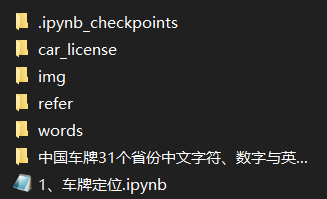import cv2
from matplotlib import pyplot as plt
import os
import glob
import numpy as np
def cv_show(name, img):
cv2.imshow(name, img)
cv2.waitKey(0)
cv2.destroyAllWindows()
def plt_show0(img):
b, g, r = cv2.split(img)
img = cv2.merge([r, g, b])
plt.imshow(img)
plt.show()
def plt_show(img):
plt.imshow(img, cmap='gray')
plt.show()
def read_directory(directory_name):
referImg_list = []
for filename in os.listdir(directory_name):
referImg_list.append(directory_name+"/"+filename)
return referImg_list
rawImage = cv2.imread('./img/car2.png')
plt_show0(rawImage)
image = cv2.GaussianBlur(rawImage,(3,3),0)
gray_image = cv2.cvtColor(image,cv2.COLOR_RGB2GRAY)
Sobel_y = cv2.Sobel(gray_image,cv2.CV_16S,1,0)
absY = cv2.convertScaleAbs(Sobel_y)
image = absY
ret,image = cv2.threshold(image,0,255,cv2.THRESH_OTSU)
kernelX = cv2.getStructuringElement(cv2.MORPH_RECT,(17,5))
image = cv2.morphologyEx(image,cv2.MORPH_CLOSE,kernelX,iterations = 1)
kernelX = cv2.getStructuringElement(cv2.MORPH_RECT,(17,1))
kernelY = cv2.getStructuringElement(cv2.MORPH_RECT,(1,13))
image = cv2.dilate(image,kernelX)
image = cv2.erode(image,kernelX)
image = cv2.erode(image,kernelY)
image = cv2.dilate(image,kernelY)
image = cv2.medianBlur(image,15)
contours,hierarchy = cv2.findContours(image,cv2.RETR_EXTERNAL,cv2.CHAIN_APPROX_SIMPLE)
image1= rawImage.copy()
cv2.drawContours(image1,contours,-1,(0,0,255),5)
image2= rawImage.copy()
hsv = cv2.cvtColor(image2, cv2.COLOR_BGR2HSV)
lower_blue = (100, 43, 46)
upper_blue = (124, 255, 255)
lower_green = (35, 43, 46)
upper_green = (77, 255, 255)
mask_blue = cv2.inRange(hsv, lower_blue, upper_blue)
mask_green = cv2.inRange(hsv, lower_green, upper_green)
kernel = cv2.getStructuringElement(cv2.MORPH_RECT, (5, 5))
mask_blue = cv2.morphologyEx(mask_blue, cv2.MORPH_OPEN, kernel)
mask_green = cv2.morphologyEx(mask_green, cv2.MORPH_OPEN, kernel)
mask = cv2.bitwise_or(mask_blue, mask_green)
filtered = cv2.bitwise_and(image2, image2, mask=mask)
plates = []
for contour in contours:
area = cv2.contourArea(contour)
x, y, w, h = cv2.boundingRect(contour)
ratio = w / h
if ratio < 2 or ratio > 6:
print('长宽不通过')
continue
rect_area = w * h
coverage = area / rect_area
if coverage < 0.5:
print('矩形和轮廓的覆盖率不通过')
continue
mask_area = cv2.countNonZero(mask[y:y+h, x:x+w])
mask_coverage = mask_area / rect_area
if mask_coverage < 0.5:
print('掩膜覆盖率不通过')
continue
plates.append((x, y, w, h))
if len(plates) == 0:
print("No plates found.")
elif len(plates) > 1:
print("Multiple plates found.")
else:
x, y, w, h = plates[0]
image4 = image2.copy()
cv2.rectangle(image2, (x, y), (x+w, y+h), (0, 255, 0), 1)
plt_show0(image2)
image3 = image4[y:y+h,x:x+w]
cv2.imwrite('./car_license/test1.png',image3)
license = cv2.imread('./car_license/test1.png')
licence_GB = cv2.GaussianBlur(license,(1,3),0)
licence_gray = cv2.cvtColor(licence_GB,cv2.COLOR_BGR2GRAY)
ret , img = cv2.threshold(licence_gray,0,255,cv2.THRESH_OTSU)
import numpy as np
mean = np.mean(img)
if mean > 128:
img = 255 - img
kernel = cv2.getStructuringElement(cv2.MORPH_RECT,(2,1))
img_close = cv2.dilate(img,kernel)
number_contours , hierarchy = cv2.findContours(img_close,cv2.RETR_EXTERNAL,cv2.CHAIN_APPROX_SIMPLE)
img1 = license.copy()
cv2.drawContours(img1,number_contours,-1,(0,255,0),1)
plt_show(img1)
chars = []
for cnt in number_contours:
x, y, w, h = cv2.boundingRect(cnt)
if w < 5 or h < 10 or w > 50 or h > 50:
continue
ratio = w / h
if ratio < 0.25 or ratio > 0.7:
continue
chars.append((x, y, w, h))
chars = sorted(chars, key=lambda x: x[0])
i = 0
for x, y, w, h in chars:
i = i+1
char = license[y:y+h, x:x+w]
char = cv2.resize(char, (64, 64))
cv2.imwrite('./words/test2_'+str(i)+'.png',char)
templates = ['0','1','2','3','4','5','6','7','8','9','A','B','C','D','E','F','G','H','J','K','L','M','N','P','Q','R','S','T','U','V','W','X','Y','Z','京','津','冀','晋','蒙','辽','吉','黑','沪','苏','浙','皖','闽','赣','鲁','豫','鄂','湘','粤','桂','琼','渝','川','贵','云','藏','陕','甘','青','宁','新']
folder_path = './words/'
image_format = '*.png'
images_path = glob.glob(folder_path + image_format)
def method_A(imageA):
c_words = []
for i in range(34, 64):
c_word = read_directory('./refer/' + templates[i])
c_words.append(c_word)
chinese_Gaussian = cv2.GaussianBlur(imageA, (3, 3), 0)
chinese_gray = cv2.cvtColor(chinese_Gaussian, cv2.COLOR_RGB2GRAY)
ret, chinese_threshold = cv2.threshold(chinese_gray, 0, 255, cv2.THRESH_OTSU)
mean = np.mean(chinese_threshold)
if mean > 100:
chinese_threshold = 255 - chinese_threshold
best_score = []
for c_word in c_words:
score = []
for word in c_word:
template_img = cv2.imdecode(np.fromfile(word, dtype=np.uint8), 1)
template_img = cv2.cvtColor(template_img, cv2.COLOR_RGB2GRAY)
ret, template_img = cv2.threshold(template_img, 0, 255, cv2.THRESH_OTSU)
height, width = template_img.shape
image_c = chinese_threshold.copy()
image_c = cv2.resize(image_c, (width, height))
result = cv2.matchTemplate(image_c, template_img, cv2.TM_CCOEFF)
score.append(result[0][0])
best_score.append(max(score))
best = best_score.index(max(best_score))
best_chinese = templates[34 + best]
print(best_chinese)
pass
def method_B(imageA):
E_words = []
for i in range(10, 34):
E_word = read_directory('./refer/' + templates[i])
E_words.append(E_word)
English_Gaussian = cv2.GaussianBlur(imageA, (3, 3), 0)
English_gray = cv2.cvtColor(English_Gaussian, cv2.COLOR_RGB2GRAY)
ret, English_threshold = cv2.threshold(English_gray, 0, 255, cv2.THRESH_OTSU)
mean = np.mean(English_threshold)
if mean > 100:
English_threshold = 255 - English_threshold
best_score = []
for E_word in E_words:
score = []
for word in E_word:
template_img = cv2.imdecode(np.fromfile(word, dtype=np.uint8), 1)
template_img = cv2.cvtColor(template_img, cv2.COLOR_RGB2GRAY)
ret, template_img = cv2.threshold(template_img, 0, 255, cv2.THRESH_OTSU)
height, width = template_img.shape
image_E = English_threshold.copy()
image_E = cv2.resize(image_E, (width, height))
result = cv2.matchTemplate(image_E, template_img, cv2.TM_CCOEFF)
score.append(result[0][0])
best_score.append(max(score))
best = best_score.index(max(best_score))
best_English = templates[10 + best]
print(best_English)
pass
def method_C(imageA):
E_words = []
for i in range(0, 34):
E_word = read_directory('./refer/' + templates[i])
E_words.append(E_word)
English_Gaussian = cv2.GaussianBlur(imageA, (3, 3), 0)
English_gray = cv2.cvtColor(English_Gaussian, cv2.COLOR_RGB2GRAY)
ret, English_threshold = cv2.threshold(English_gray, 0, 255, cv2.THRESH_OTSU)
mean = np.mean(English_threshold)
if mean > 100:
English_threshold = 255 - English_threshold
best_score = []
for E_word in E_words:
score = []
for word in E_word:
template_img = cv2.imdecode(np.fromfile(word, dtype=np.uint8), 1)
template_img = cv2.cvtColor(template_img, cv2.COLOR_RGB2GRAY)
ret, template_img = cv2.threshold(template_img, 0, 255, cv2.THRESH_OTSU)
height, width = template_img.shape
image_E = English_threshold.copy()
image_E = cv2.resize(image_E, (width, height))
result = cv2.matchTemplate(image_E, template_img, cv2.TM_CCOEFF)
score.append(result[0][0])
best_score.append(max(score))
best = best_score.index(max(best_score))
best_English = templates[0 + best]
print(best_English)
pass
count = 0
for image_path in images_path:
imageA = cv2.imread(image_path)
if count == 0:
method_A(imageA)
elif count == 1:
method_B(imageA)
else:
method_C(imageA)
count += 1
|








